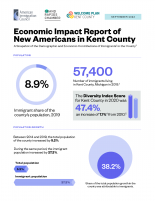- Research and Analysis
New Americans in Kent County
Published
New research from the American Immigration Council, highlights the significant economic contributions immigrants made in Kent County and West Michigan. Notably in 2021, immigrants in Kent County held $1.6 billion in spending power, paid $318.8 million in federal taxes, and paid $173.9 million in state and local taxes. The new report, Economic Impact Report of New Americans in Kent County, was done in partnership with the Grand Rapids Chamber.
Between 2014 and 2019, the population of Kent County increased by 5.2 percent, and the immigrant population grew by 27.2 percent, with 38.2 percent of total population growth in the county being attributable to immigrants. Despite making up 8.9 percent of the county's total population in 2019, immigrants represented 10.5 percent of its employed labor force. In 2021 alone, immigrant households in the county earned $2.0 billion in income and contributed $4.9 billion to the area’s gross domestic product (GDP), or 9.0% of the total GDP for that year.
The report also features profiles of community members: Natalia Kovicak, Sonal and Ramesh Patel, Romel “RC” Caylan, and Ruben Ramos.
Read the press release here.
-
Immigrants are helping the county meet its labor force demands. In 2019, immigrants were 27.3 percent more likely to be of working age than their U.S.-born counterparts, allowing them to actively participate in the labor force and contribute to the economy as taxpayers and consumers.
-
Immigrants support the federal safety net. In 2021, they contributed $192.3 million to Social Security and $47.8 million to Medicare.
-
Immigrants are helping Kent County meet its rising labor needs in key industries. While making up 8.9 percent of the county’s total population in 2019, immigrants represented 53.1 percent of agriculture workers, 15.3 percent of construction workers, and 14.8 percent of transportation and warehouse workers.
-
Immigrants in Kent County help create or preserve local manufacturing jobs. Immigrants strengthened the local job market by allowing companies to keep jobs on U.S. soil, helping preserve or create 2,600 local manufacturing jobs that would have otherwise been eliminated or moved elsewhere by 2019.
Help us fight for immigration justice!
The research is clear – immigrants are more likely to win their cases with a lawyer by their side. But very few can get attorneys.
Introducing the Immigration Justice Campaign Access Fund.
Your support sends attorneys, provides interpreters, and delivers justice.

Immigration Justice Campaign is an initiative of American Immigration Council and American Immigration Lawyers Association. The mission is to increase free legal services for immigrants navigating our complicated immigration system and leverage the voices and experiences of those most directly impacted by our country’s immigration policies to inform legal and advocacy strategies. We bring together a broad network of volunteers who provide legal assistance and advocate for due process for immigrants with a humane approach that includes universal legal representation and other community-based support for individuals during their immigration cases.

